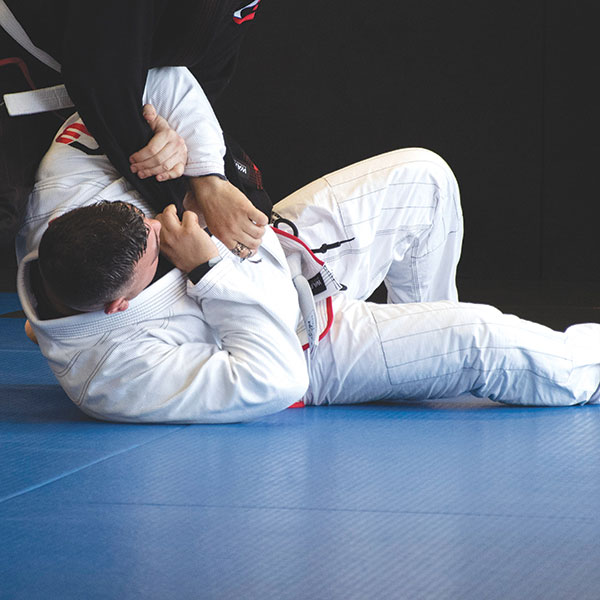Law enforcement is perhaps the highest risk profession in our country. With the goal to make it home safe each day, officers face danger and risk from the unpredictability they encounter with every call. As a mother of a former police officer, I know the worry doesn’t end with the officer. It extends to family and friends.
Placer County Deputy Paul Solbos founded Warriors Always Ready, a nonprofit that provides high-quality physical and mental training for first responders and veterans through his Code3 Brazilian jiu-jitsu program.
Solbos’ inspiration was a call for service that put him in serious doubt he would make it home safe. His story begins like so many tragic law enforcement stories.

“It was a routine call for service, the type of call I’d been on many times before,” Solbos says. When he arrived, the situation quickly escalated. He had to go hands-on to defend himself.
“Everything went through my mind. I fought intensely for my life for several minutes until I was able to call for help on my radio. I was physically exhausted, and extremely uncomfortable that I didn’t have the level of training to overcome this opponent, who obviously did,” he says.
“It really got into my head. I was very lucky I finally got control of him.”
Shaken by his experience, Solbos realized getting home safe isn’t enough. He had to shift the odds in his favor—and for his colleagues.
The most effective training he found is Brazilian jiu-jitsu, a martial art focused on getting the opponent to the ground and gaining control by offsetting physical strength with technique. The meaning of jiu-jitsu translates from Japanese to the “gentle art.”
California’s Commission on Peace Officer Standards and Training requires officers to update their training during two-year cycles. Part of that training involves arrest control tactics.
At a Synergy Jiu-Jitsu Academy class, Placer Deputy John Tannarome explains arrest control “teaches techniques that work for compliant or semi-compliant subjects. It falls short when it comes to very combative, noncooperative subjects. (Brazilian jiu-jitsu) fills that gap in training.”
He says tasers and other equipment are useful but can malfunction, so it’s important for an officer to know what their bodies can do. Solbos agrees: “If I must go up against the biggest, meanest person, I want them to know I’m in the fight. If they’re going to take me, they’re going to have to work for it. This class absolutely gets me there.”
On the value of practicing Brazilian jiu-jitsu, Placer Deputy Dan Cunningham says, “I’d rather lose a thousand times in here than to lose once while on patrol.”
The local Code3 team is not alone in seeing the benefit of Brazilian jiu-jitsu. Two years ago, the police department in Marietta, Georgia, began requiring newly hired officers to attend a minimum of one Brazilian jiu-jitsu training session per week while in field training.
The stats in Marietta back up the program’s success. In the jiu-jitsu trained group, Marietta reported a 48-percent reduction of injuries to officers using force, a 53-percent reduction of injuries to the person being arrested when force was required, and a 23-percent reduction of taser use.
Stats from a similar program in St. Paul show a 25-percent reduction of injuries to officers using force, a 44-percent reduction of injuries to persons being arrested when force was required, and a 39-percent reduction of taser use. St. Paul reports police misconduct settlements have fallen to their lowest in a decade.
Sacramento Sheriff’s Academy coordinator Sergeant Jeff Bell spent 11 years learning Brazilian jiu-jitsu and has incorporated it into academy curriculum. “The biggest benefit is the calmness I experience in situations that previously could have brought a less mindful response,” Bell says.
Academy coordinator Sergeant Tyrone Carey says, “We need to keep up with the times. A lot of people understand how to fight, train or box. Transitioning to this new approach will keep us and the public safer.”
Tannarome notes Brazilian jiu-jitsu does not employ violent tactics and helps de-escalate confrontations. The technique “reduces both the need for us to use our weapons and from injuring ourselves and others,” he says. “Anyone who says otherwise is ignorant.”
Brazilian jiu-jitsu training is a win-win for our vulnerable law enforcement officers and their families, and a way to keep our communities safer. Let’s hope all local law enforcement agencies encourage this approach.
Visit c3bjj.org or on social media @c3bjj.
Cecily Hastings can be reached at publisher@insidepublications.com. Follow us on Facebook and Instagram: @insidesacramento.














